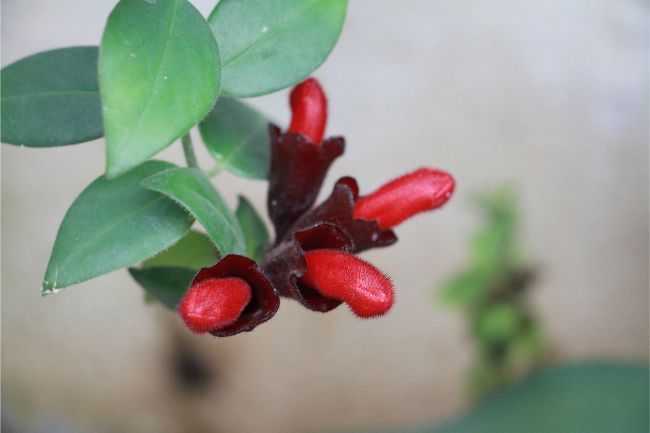When covered in an elaborate display of its scarlet flowers, it’s easy to see why Aeschynanthus radicans gets its common name Lipstick Plant. Provided proper growing conditions and care, this easy-to-grow houseplant will grace indoor spaces with its robust growth and colorful blooms for years to come. We have outlined a quick summary of Lipstick Plant care below.
How To Care For A Lipstick Plant: Pot your Lipstick Plant in fertile soil that drains well and water when the top quarter of soil becomes dry. Provide high humidity, situate in bright, indirect light and maintain indoor temperatures of 75°F to 85°F.
Whether you are a novice or experienced gardener, continue reading because we’ve outlined all the top tips for properly growing and caring for a thriving indoor Lipstick Plant.
How To Care For A Lipstick Plant
Lipstick Plant, also called Lipstick Vine is native to the tropical and humid rainforests of Java north to the Malay Peninsula where the long, trailing vines grow and scramble along trees.
It belong in the Gesneriaceae family, which is the same family as the fussy African Violet, and the genus Aeschynanthus that includes around 150 different species of tropical plants, including the Lipstick Plant.
Only those living in frost-free climates will have success growing a Lipstick Plant outdoors. However, those experiencing a more temperate climate will not be disappointed because this flowering epiphyte thrives as an indoor houseplant when grown in its preferred conditions.
It makes the perfect choice for use in hanging baskets, as the stems grow 2-feet long or even longer and will bring a bit of the tropics indoors wherever placed.
It is easy to see where the plant gets its common name, Lipstick Plant as the bright 2-inch, reddish-orange tubular flowers with yellow throats emerge from their calyx resembling tubes of lipstick. When given adequate light, you can enjoy the colorful blooms periodically throughout the entire year. The cultivar ‘Variegata’ has foliage splashed in white.
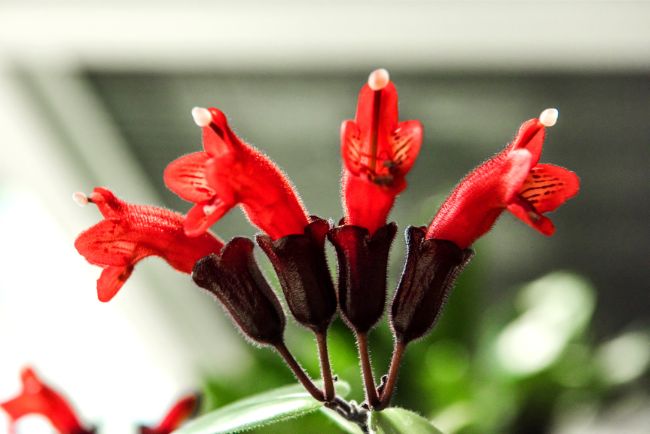
Lipstick Plant Soil Conditions
To ensure good Aeschynanthus care, make sure you use soil that is well aerated and isn’t heavy, as heavier soils don’t drain properly and remain too wet.
A potting mix designed specifically for houseplants works well or even a fertile, lightweight regular potting mix is suitable. Some blends contain a slow-release fertilizer, which will cut down on the need for frequent feedings.
Most potting soils have a tendency to be heavy and will need to be cut with another substance that is lighter in weight, which will produce the adequate drainage required for healthy growth. You can create your own potting mix by using one of the following mixes:
- One part potting soil, one part potting mix, one part peat
- One part potting soil, one part peat, one part perlite
- One part compost, one part peat, one part potting soil
Although the Lipstick plant will require more care when it comes to proper moisture, you can also grow the plant on a wooden board or other structure typically used for growing orchids. When grown like this, the Lipstick Plant will require more frequent water applications to keep the roots moist.
Lipstick Plant Light Requirements
To promote the best production of blooms, it’s imperative to place the Lipstick Plant in an indoor location receiving bright indirect light. However, do not place it in a location where the plant receives direct sunlight or the foliage can burn.
If your Lipstick Plant is failing to bloom and the stems are long and scraggly looking, more than likely the plant isn’t receiving adequate light.
Once the weather warms in springtime, if you want to allow your Lipstick Plant to have a bit of a break from indoor growth, you can set it outside in a partially shady location. The direct rays of the sun are stronger outdoors than when they are filtered through a window coming indoors, so just be sure not to place it in a location that’s too sunny or you will end up with fried leaves.
Indoor Temperature Requirements Of The Lipstick Plant
Indoor temperatures ranging between 75°F to 85°F promote the best growth and flowering. Lipstick Plants will tolerate temperatures down to 60°F but the growth slows. When indoor temperatures drop to 50°F or lower, the plant suffers tissue damage and leaf drop.
Just remember, these plants are native to tropical locations where temperatures throughout the year are consistently warm.
How Much Water Does Lipstick Plant Need?
When it comes to properly watering your Lipstick Plant, it is best to allow the top quarter of soil to dry before watering. In fact, waiting to water until the top portion of soil is dry actually promotes blooming. In addition, whether the plant is in the growing season or its season of dormancy also affects the frequency of water applications.
- Spring through Summer: During the active growing season, you may have to water an average of once weekly.
- Fall through Winter: During the cooler months of the year, the Lipstick Plant’s growth slows, so therefore it requires less water. You will probably only need to water once every two to three weeks.
An easy way to check the soil’s moisture level is by sticking your finger into the soil and if the top quarter feels dry apply water. Always water until it runs from the bottom drain holes of the container.
Signs your Lipstick Plant isn’t getting enough water is shriveled leaves. If you are overwatering the plant, the foliage starts losing its shiny green color. For the health of the plant, it is better to miss a watering than to regularly apply too much.
Watering is one of the trickiest things to get right when it comes to indoor plants. It’s by far the most common cause of problems. I’ve written an article that can help you properly assess when and how much to water your indoor plants to keep them thriving.
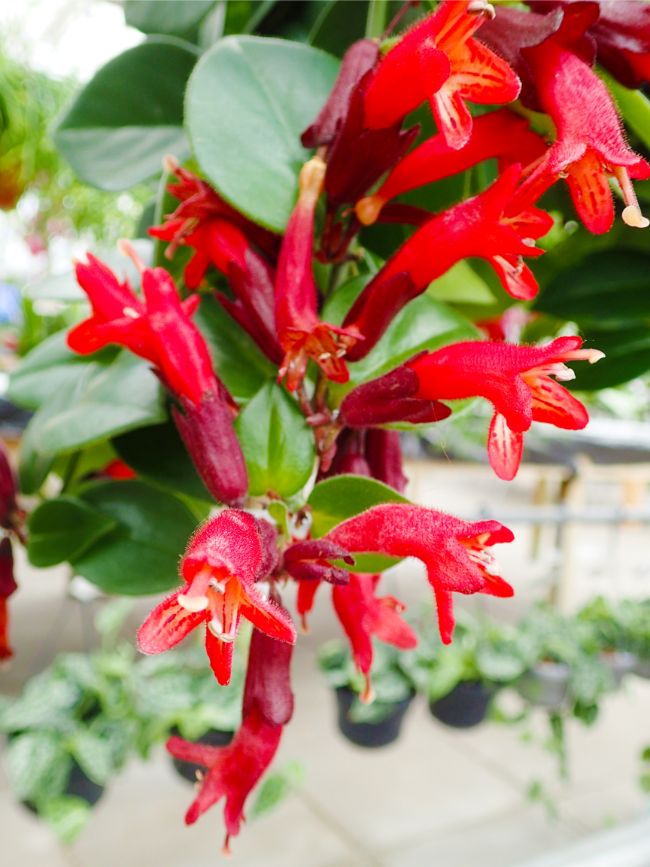
Humidity Requirements
Since Lipstick Plants are native to tropical rainforests, where humidity levels are consistently high, it is important you replicate the humid conditions indoors. Creating humidity for an indoor plant is easy and you have several options for meeting your Lipstick Plant’s needs for healthy growth.
- Fill a spray bottle up with room temperature water and mist the Lipstick Plant several times weekly.
- If your Lipstick Plant isn’t growing in a hanging basket but in a regular container, fill a tray up with small pebbles and set the pot on top of it. As you water, it drains from the pot into the tray and as the water evaporates, it creates humidity around the Lipstick Plant.
- If light conditions are adequate for proper growth and blooming inside your bathroom, you can grow the Lipstick Plant there. The regular use of water inside the room creates a humid environment for the plant.
To maintain proper humidity around the Lipstick Plant, don’t place it in an indoor location next to a heating or cooling vent that dries the air. Learn more about how to get the perfect humidity level for your indoor plants by reading my helpful article.
What Fertilizer Does Lipstick Plant Need?
If the potting mix you used contains a slow-release fertilizer incorporated into it, you won’t have to worry about replenishing the fertilizer for up to three months. This cuts down on the need for more frequent applications. After three months, apply another feeding of a slow-release blend and the plant is good to go for several more months.
You can also feed the Lipstick Plant using a water-soluble houseplant blend applied at half-strength. Throughout the growing season of spring through summer, feed the Lipstick plant every two weeks. Stop the feedings while the plant is dormant in fall and winter.
If you notice the tips of the leaves on your Lipstick Plant turning brown, this can be an indication of too much salt in the soil from the fertilizer. It is a good practice to flush the salts from the soil every three to four months. Flushing the soil is easy.
- Take the Lipstick Plant to the sink and allow the water to run slowly through the soil for about five minutes, removing the salt buildup. Allow the container to drain and place back in its indoor location.
If you’d like to learn about some of the best natural options to fertilize your indoor plants, I’ve covered some of the best options in another article.
Lipstick Plant Pruning
To promote bushier growth, you can prune back the long stems on your Lipstick Plant, cutting off about a third. This keeps the plant from becoming leggy and looking straggly. It’s best to wait until after the blooming has finished before pruning.
In addition, since the flowers form at the leaf tips, pruning will create more blooms for you to enjoy. A pair of scissors or hand pruners will work well and always cut right above a leaf node.
Always make sure the blades of your pruning tools are clean so you don’t transfer disease to your Lipstick Plant. Wiping the blades off with rubbing alcohol does the trick.
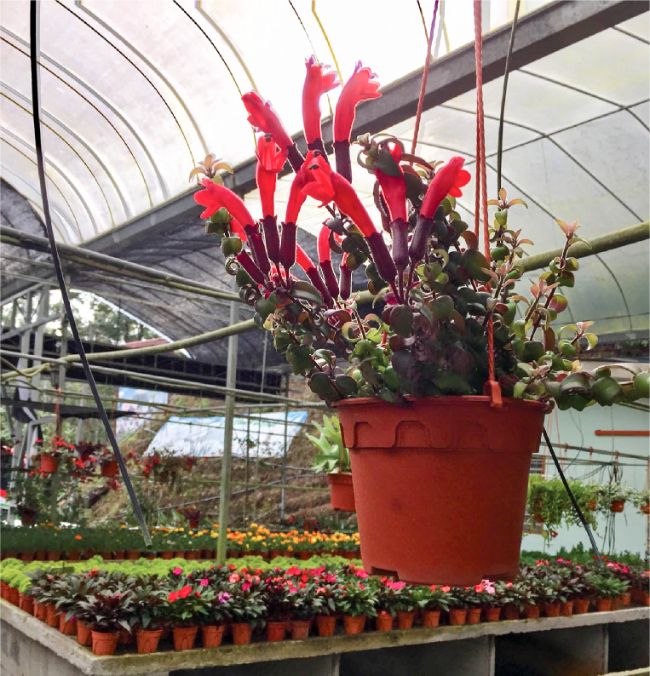
Repotting Lipstick Plant
The only time you will need to repot your Lipstick Plant is if it has outgrown its current pot and the roots are filling the bottom. Use a container that is one size larger than the present one and repotting is best done while your Aeschynanthus is actively growing in spring through summer.
The steps to repotting your Lipstick Plant are basic:
- Prepare the new container by filling it about a quarter full of a fertile, lightweight potting mix that drains well. Water the soil to help settle it. Make sure the container has bottom drainage.
- Carefully remove the Lipstick Plant from its present container and inspect the roots for wrapping. Gently tease any wrapping roots apart, if needed.
- Set the Lipstick Plant in the new container, adding or removing soil so it will be growing at the same height it is presently. You do not want to plant too deep or problems with rot can occur.
- Fill the remainder of the container up with soil, firming it up around the Lipstick Plant.
- Water the container again and until it runs from the bottom drains hole. Place the Lipstick Plant back where it was previously growing indoors.
Your Lipstick Plant isn’t fussy about the pot’s material, but if the container is made from a porous material like terracotta, the soil will dry out faster than in a plastic pot.
Lipstick Plant Propagation
Don’t throw those cuttings away when you prune the Lipstick Plant back, because you can use them to propagate new plants. Using 4- to 6-inch cuttings work well in establishing new plants. Plant them using the same process as you would when repotting the entire plant.
- Fill a draining container up with a rich, well-drained soil and then water to settle it.
- Make 1.5-inch deep holes in the soil and place the cut end of the Lipstick Plant cutting into each one, firming the soil up around it.
- Water the soil again and place the container in a warm location receiving bright, indirect light.
After about four to six weeks, your Lipstick Plant cuttings should form roots.
Disease Problems
The fungal problem Botrytis blight (Botrytis cinerea) is the biggest disease problem affecting Lipstick Plants grown as houseplant. The problem rears its ugly head through black spots and lesions appearing on the foliage or the entire stem.
Conditions are worse when nighttime temperatures are cool and daytime temperatures are warm, and the plant is receiving a high level of moisture. It is worse during the winter months.
You can prevent the problem by reducing the amount of moisture the plant is receiving through either watering or misting for humidity. When you mist the Lipstick vine, make sure to do it during the daytime so the foliage has time to completely dry by night. In severe cases, you can spray the entire plant using a fungicide like copper.
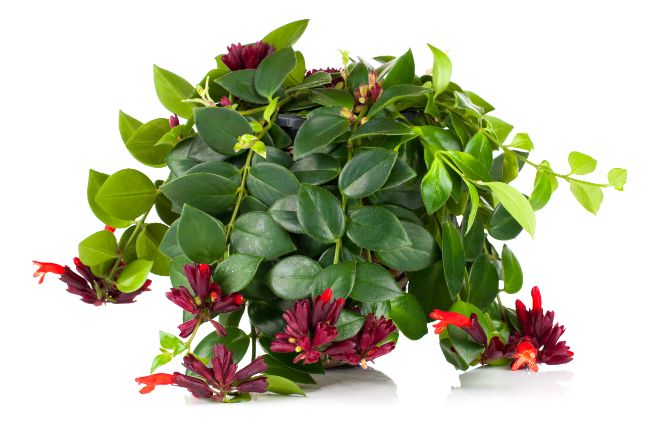
Pest Problems
Several pests can infest an indoor grown Lipstick Plant. It is always best to catch and treat the problem early, so be sure to inspect your plant each time you water. This also prevents the pests traveling to your other indoor plants.
With all these pests, if the infestation is small you can wipe them off the plant using a damp cloth. In the case of larger infestations, you can spray the entire plant using an insecticidal soap or neem. Follow the package direction on amounts and frequency of use.
- Mealybugs: Mealybugs show up on the plant as large cottony masses on the stems or their crotches. The bugs suck the juices from the Lipstick Plant so quick action is required to prevent damage.
- Aphids: Aphids are small and pear-shaped and come in a range of different colors. They congregate in masses along the Lipstick Plant’s stems and flower buds. They too suck juices from the plant, damaging it.
- Spider Mites: Spider mites are tiny mites that spin webs covering the Lipstick Plant and suck juices from it. They are probably the most damaging because they can quickly damage or kill the plant if left untreated. Read about the best ways to get rid of spider mites in your houseplants.
If you notice a pest problem with your Aeschynanthus Radicans, be sure to check your other indoor plants to make sure they haven’t traveled elsewhere.
Why Are The Leaves Falling Off My Lipstick Plant?
If your Lipstick Plant is starting to drop its leaves, it can be several problems causing the condition. If the plant isn’t getting enough water, the foliage will shrivel and eventually drop. Solve the problem by saturating the soil when the top quarter dries.
Another problem that causes leaf drop is too cold temperatures. Temperatures of 50°F and below cause leaf drop. For the best growth, keep indoor temperatures between 75°F to 85°F.
How Do You Prune A Lipstick Plant?
Pruning is best done during the growing season of spring through summer and after the Lipstick Plant finishes blooming. You can cut the stems back by a third, using clean pruning tools. Cut each stem right above a leaf node. If you plant the cuttings, new roots will form at the leaf node.
What Should I Do If My Lipstick Plant Is Thin And Straggly?
If you notice your Lipstick Plant isn’t growing robustly and the stems are looking a bit thin and straggly, the plant isn’t getting enough light. For the best indoor growth and production of flowers, the plant needs a location that received bright, indirect light. Solve the problem by moving the plant to a brighter location.
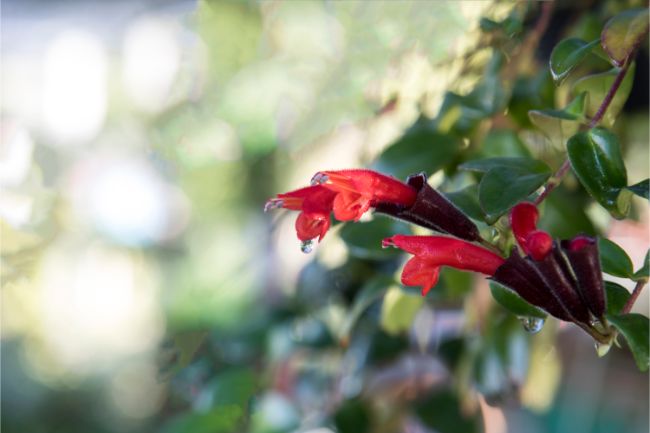
How Do I Get My Lipstick Plant Houseplant To Bloom?
Lipstick Plants bloom periodically throughout the year, with the most abundance of flowers in spring through summer. To help promote blooming, make sure your plant is situated in bright, indirect light and allow the soil to dry out a bit before watering.
You can also use a water-soluble fertilizer high in potassium, the second number in the formula, which promotes flowering. Apply every two weeks at half-strength.
Why Do My Lipstick Plant’s Leaves Have Black Spots?
If your Lipstick vine is developing black, water-soaked areas on the leaves, it has the fungal problem botrytis blight. The condition is most prevalent during winter when nights are cold and days are warm, and there’s an increase in moisture to the plant.
You can trim off the affected leaves and reduce moisture around the plant by misting only during the daytime hours so the foliage has time to dry by night. You can also spray the plant with a copper fungicide.
Is Lipstick Plant Poisonous To Cats?
Lipstick Plants are considered non-toxic to dogs, cats and horses.
How Big Do Lipstick Plants Get?
When properly cared for and grown in proper conditions, Lipstick Plant vines can grow 2- to 3-feet long.

